Nematicidal Properties and Chemical Composition of Pinus rigida Mill. Resin against Pinewood Nematodes
Abstract
1. Introduction
2. Materials and Methods
2.1. PWN Propagation
2.2. PWN Migration on PWN-Inoculated Stems
2.3. Resin Toxicity to PWNs
2.4. Mortality of PWNs by Resin Treatment
2.5. GC–MS Analysis of Resin Compositions in Pinus Species
2.6. PWN Toxicity of Two Pinosylvin Stilbenes
2.7. Statistics
3. Results
3.1. Migration of PWNs in Stems of P. densiflora, P. koraiensis and P. rigida
3.2. PWN Mobility in Resins from P. densiflora, P. koraiensis, and P. rigida
3.3. Mortality of PWNs in Resins from P. densiflora, P. koraiensis, and P. rigida
3.4. Chemical Composition of Resins from P. densiflora, P. koraiensis, and P. rigida
3.5. Nematicidal Activity of 3,5-Dimethoxystilbene against PWNs
4. Discussion
4.1. Inhibition of PWN Migration in Pine Stems
4.2. Resin Toxicity against PWNs
4.3. Chemical Composition of Resins Extracted from P. densiflora, P. koraiensis, and P. rigida
4.4. Toxicity of 3,5-Dimethoxystilbene against PWNs
5. Conclusions
Author Contributions
Funding
Institutional Review Board Statement
Informed Consent Statement
Data Availability Statement
Conflicts of Interest
References
- Jones, J.T.; Haegeman, A.; Danchin, E.G.J.; Gaur, H.S.; Helder, J.; Jones, M.J.K.; Kikuchi, T.; Manzanilla-López, R.; Palomares-Rius, J.E.; Wesemael, W.M.L.; et al. Top 10 plant-parasitic nematodes in molecular plant pathology. Mol. Plant Pathol. 2013, 14, 946–961. [Google Scholar] [CrossRef] [PubMed]
- Ichihara, Y.; Fukuda, K.; Suzuki, K. Early symptom development and histological changes associated with migration of Bursaphelenchus xylophilus in seedling tissues of Pinus thunbergii. Plant Dis. 2000, 84, 675–680. [Google Scholar] [CrossRef] [PubMed]
- Futai, K. Pine Wood Nematode, Bursaphelenchus Xylophilus. Annu. Rev. Phytopathol. 2013, 51, 61–83. [Google Scholar] [CrossRef] [PubMed]
- Ikeda, T. Responses of water-stressed Pinus thunbergii to inoculation with avirulent pine wood nematode (Bursaphelenchus xylophilus): Water relations and xylem histology. J. For. Res. 1996, 1, 223–226. [Google Scholar] [CrossRef]
- Linit, M.J. Nematode-vector relationships in the pine wilt disease system. J. Nematol. 1988, 20, 227–235. [Google Scholar]
- James, R.; Tisserat, N.; Todd, T. Prevention of pine wilt of scots pine (Pinus sylvestris) with systemic abamectin injections. Arboric. Urban For. 2006, 32, 195–201. [Google Scholar] [CrossRef]
- Sousa, E.; Naves, P.; Vieira, M. Prevention of pine wilt disease induced by Bursaphelenchus xylophilus and Monochamus galloprovincialis by trunk injection of emamectin benzoate. Phytoparasitica 2013, 41, 143–148. [Google Scholar] [CrossRef]
- Kim, B.-N.; Kim, J.H.; Ahn, J.-Y.; Kim, S.; Cho, B.-K.; Kim, Y.-H.; Min, J. A short review of the pinewood nematode, Bursaphelenchus xylophilus. Toxicol. Environ. Health Sci. 2020, 12, 297–304. [Google Scholar] [CrossRef]
- Kurinobu, S. Current status of resistance breeding of Japanese pine species to pine wilt disease. For. Sci. Technol. 2008, 4, 51–57. [Google Scholar] [CrossRef]
- Ribeiro, B.; Espada, M.; Vu, T.; Nóbrega, F.; Mota, M.; Carrasquinho, I. Pine wilt disease: Detection of the pinewood nematode (Bursaphelenchus xylophilus) as a tool for a pine breeding programme. For. Pathol. 2012, 42, 521–525. [Google Scholar] [CrossRef]
- Yano, S. Investigation on pine death in Nagasaki prefecture. Sanrin-Kouhou 1913, 4, 1–14. [Google Scholar]
- Mamiya, Y. Pathology of the pine wilt disease caused by Bursaphelenchus xylophilus. Annu. Rev. Phytopathol. 1983, 21, 201–220. [Google Scholar] [CrossRef] [PubMed]
- Hanawa, F.; Yamada, T.; Nakashima, T. Phytoalexins from Pinus strobus bark infected with pinewood nematode, Bursaphelenchus xylophilus. Phytochemistry 2001, 57, 223–228. [Google Scholar] [CrossRef]
- Hwang, H.S.; Han, J.Y.; Choi, Y.E. Enhanced accumulation of pinosylvin stilbenes and related gene expression in Pinus strobus after infection of pine wood nematode. Tree Physiol. 2021, 41, 1972–1987. [Google Scholar] [CrossRef] [PubMed]
- Futai, K. Responses of two species of Bursaphelenchus to the extracts from pine segments and to the segments immersed in different solvents. Jpn. J. Nematol. 1979, 9, 54–59. [Google Scholar]
- Suga, T.; Ohta, S.; Munesada, K.; Ide, N.; Kurokawa, M.; Shimizu, M.; Ohta, E. Endogenous pine wood nematicidal substances in Pines, Pinus Massoniana, P. Strobus and P. Palustris. Phytochemistry 1993, 33, 1395–1401. [Google Scholar] [CrossRef]
- Harju, A.M.; Venäläinen, M. Measuring the decay resistance of scots pine heartwood indirectly by the Folin-Ciocalteu assay. Can. J. For. Res. 2006, 36, 1797–1804. [Google Scholar] [CrossRef]
- Son, J.A.; Komatsu, M.; Matsushita, N.; Hogetsu, T. Migration of pine wood nematodes in the tissues of Pinus thunbergii. J. For. Res. 2010, 15, 186–193. [Google Scholar] [CrossRef]
- Kawaguchi, E. Relationship between the anatomical characteristics of cortical resin canals and migration of Bursaphelenchus xylophilus in stem cuttings of Pinus thunbergii seedlings. J. Jpn. For. Soc. 2006, 88, 240–244. [Google Scholar] [CrossRef][Green Version]
- Oku, H.; Shiraishi, T.; Chikamatsu, K. Active defense as a mechanism of resistance in pine against pine wilt disease. Jpn. J. Phytopathol. 1989, 55, 603–608. [Google Scholar] [CrossRef]
- Nunes da Silva, M.; Lima, M.R.M.; Vasconcelos, M.W. Susceptibility evaluation of Picea abies and Cupressus lusitanica to the pine wood nematode (Bursaphelenchus xylophilus). Plant Pathol. 2013, 62, 1398–1406. [Google Scholar] [CrossRef]
- Kuroda, K. Inhibiting factors of symptom development in several Japanese red pine (Pinus densiflora) families selected as resistant to pine wilt. J. For. Res. 2004, 9, 217–224. [Google Scholar] [CrossRef]
- Son, J.A.; Matsushita, N.; Hogetsu, T. Migration of Bursaphelenchus xylophilus in cortical and xylem axial resin canals of resistant pines. For. Pathol. 2014, 45, 246–253. [Google Scholar] [CrossRef]
- Martin, D.; Tholl, D.; Gershenzon, J.; Bohlmann, J. Methyl jasmonate induces traumatic resin ducts, terpenoid resin biosynthesis, and terpenoid accumulation in developing xylem of Norway spruce stems. Plant Physiol. 2002, 129, 1003–1018. [Google Scholar] [CrossRef]
- Bolla, R.I.; Nosser, C.; Tamura, H. Chemistry of response of pines to Bursaphelenchus xvlophilus: Resin acids. Jpn. J. Nematol. 1989, 19, 1–6. [Google Scholar]
- Zhu, L.-H.; Ye, J.; Negi, S.; Xu, X.-L.; Wang, Z.-L.; Ji, J.-Y. Pathogenicity of aseptic Bursaphelenchus xylophilus. PLoS ONE 2012, 7, e38095. [Google Scholar] [CrossRef]
- Hooper, D.J. Extraction of nematodes from plant material. In Laboratory Methods for Work with Plant and Soil Nematodes; Reference Book No. 402; Southey, J.F., Ed.; Ministry of Agriculture, Fisheries and Food, Her Majesty’s Stationery Office: London, UK, 1986; pp. 51–58. [Google Scholar]
- He, J.; Zheng, Z.P.; Zhu, Q.; Guo, F.; Chen, J. Encapsulation mechanism of oxyresveratrol by β-cyclodextrin and hydroxypropyl-β-cyclodextrin and computational analysis. Molecules 2017, 22, 1801. [Google Scholar] [CrossRef]
- Yamada, T.; Ito, S.I. Chemical defense responses of wilt resistant pine species, Pinus strobus and P. taeda, against Bursaphelenchus xylophilus infection. Nippon Shokubutsu Byori Gakkaiho 1993, 59, 666–672. [Google Scholar] [CrossRef]
- Mori, Y.; Miyahara, F.; Tsutsumi, Y.; Kondo, R. Relationship between resistance to pine wilt disease and the migration or proliferation of pine wood nematodes. Eur. J. Plant Pathol. 2008, 122, 529–538. [Google Scholar] [CrossRef]
- Phillips, M.A.; Croteau, R.B. Resin-based defenses in conifers. Trends Plant Sci. 1999, 4, 184–190. [Google Scholar] [CrossRef]
- Harju, A.M.; Venäläinen, M.; Laakso, T.; Saranpää, P. Wounding response in xylem of Scots pine seedlings shows wide genetic variation and connection with the constitutive defence of heartwood. Tree Physiol. 2009, 29, 19–25. [Google Scholar] [CrossRef] [PubMed]
- Schoeppner, A.; Kindl, H. Stilbene synthase (pinosylvine synthase) and its induction by ultraviolet light. FEBS Lett. 1979, 108, 349–352. [Google Scholar] [CrossRef]
- Gehlert, R.; Schöppner, A.; Kindl, H. Stilbene synthase from seedlings of Pinus sylvestris: Purification and induction in response to fungal infection. Mol. Plant Microbe. Interact. 1990, 3, 444–449. [Google Scholar] [CrossRef]
- Rosemann, D.; Heller, W.; Sandermann, H. Biochemical plant responses to ozone: II. Induction of stilbene biosynthesis in Scots pine (Pinus sylvestris L.) seedlings. Plant Physiol. 1991, 97, 1280–1286. [Google Scholar] [CrossRef]
- Rowe, J.W.; Bower, C.L.; Wagner, E.R. Extractives of jack pine bark: Occurrence of cis- and trans-pinosylvin dimethyl ether and ferulic acid esters. Phytochemistry 1969, 8, 235–241. [Google Scholar] [CrossRef]
- Samoylenko, V.; Dunbar, D.C.; Gafur, M.A.; Khan, S.I.; Ross, S.A.; Mossa, J.S.; El-Feraly, F.S.; Tekwani, B.L.; Bosselaers, J.; Muhammad, I. Antiparasitic, nematicidal and antifouling constituents from Juniperus berries. Phytother. Res. 2008, 22, 1570–1576. [Google Scholar] [CrossRef]
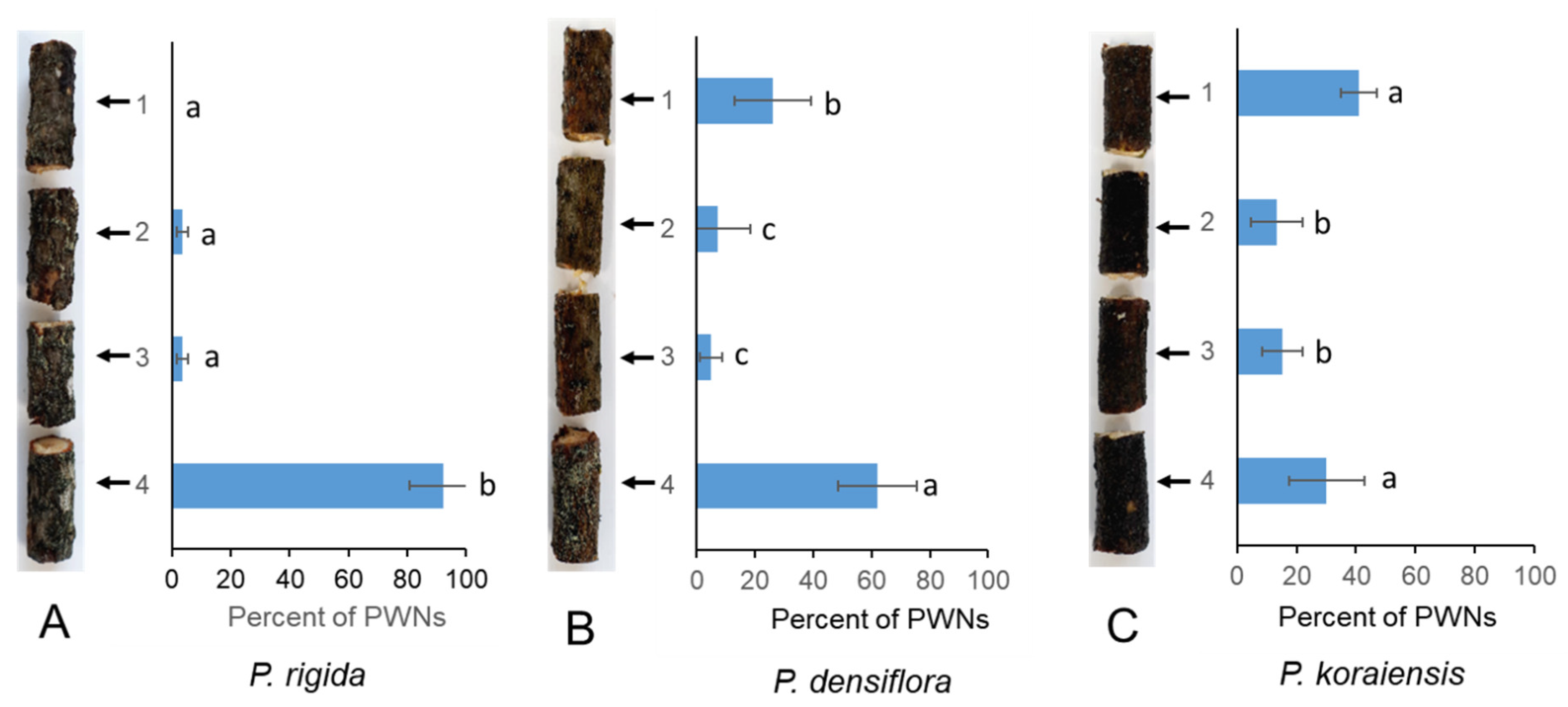
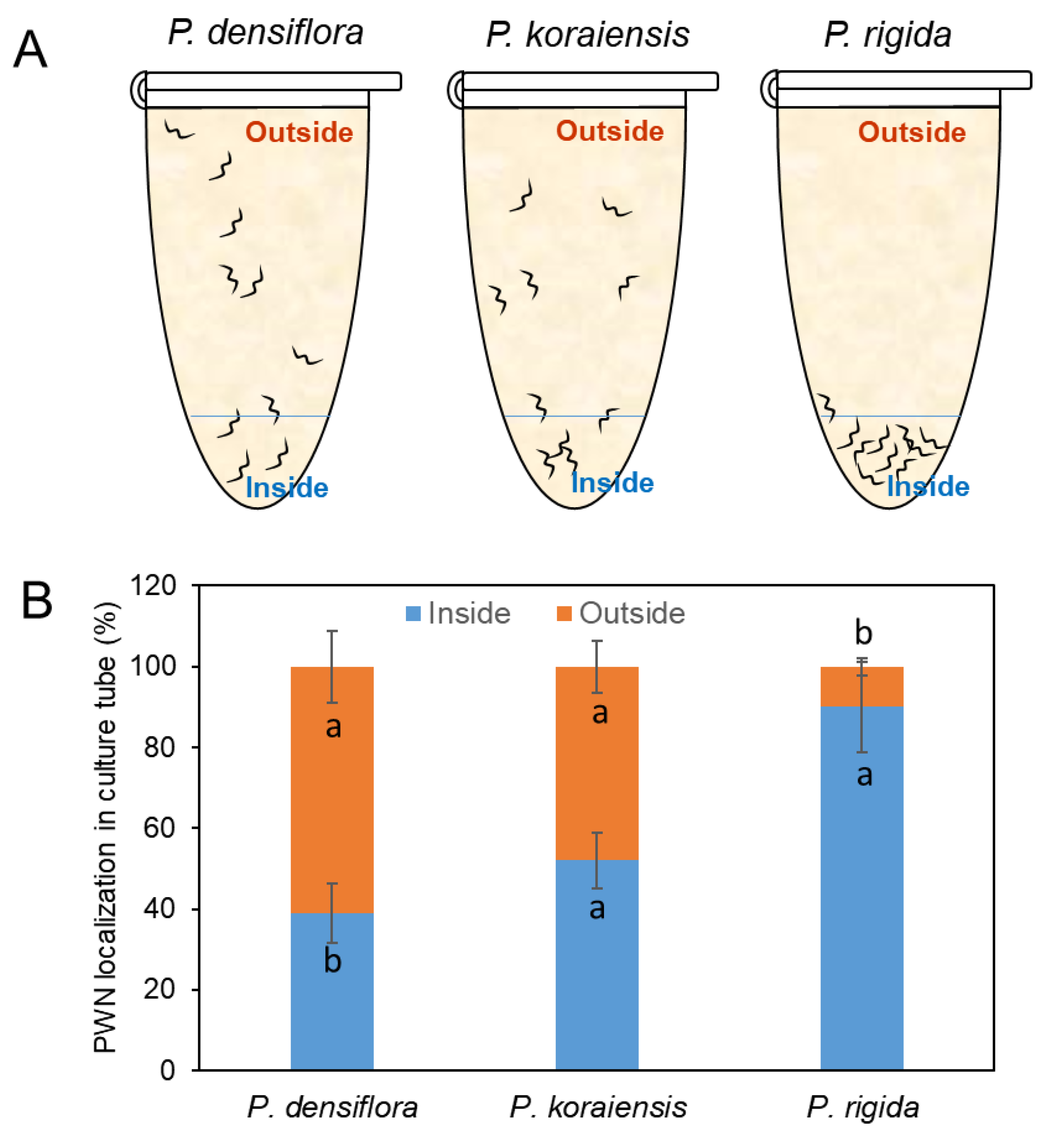
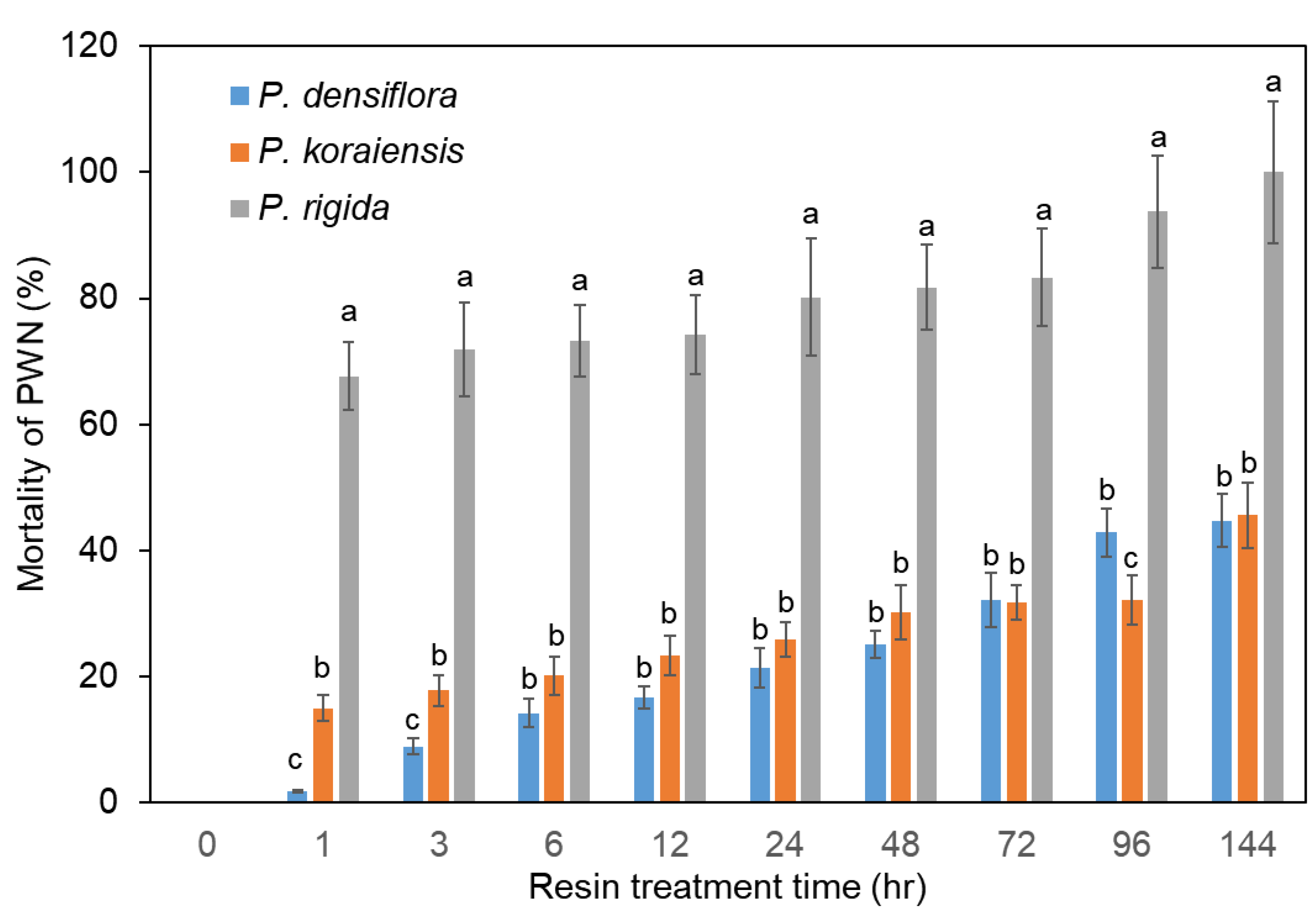
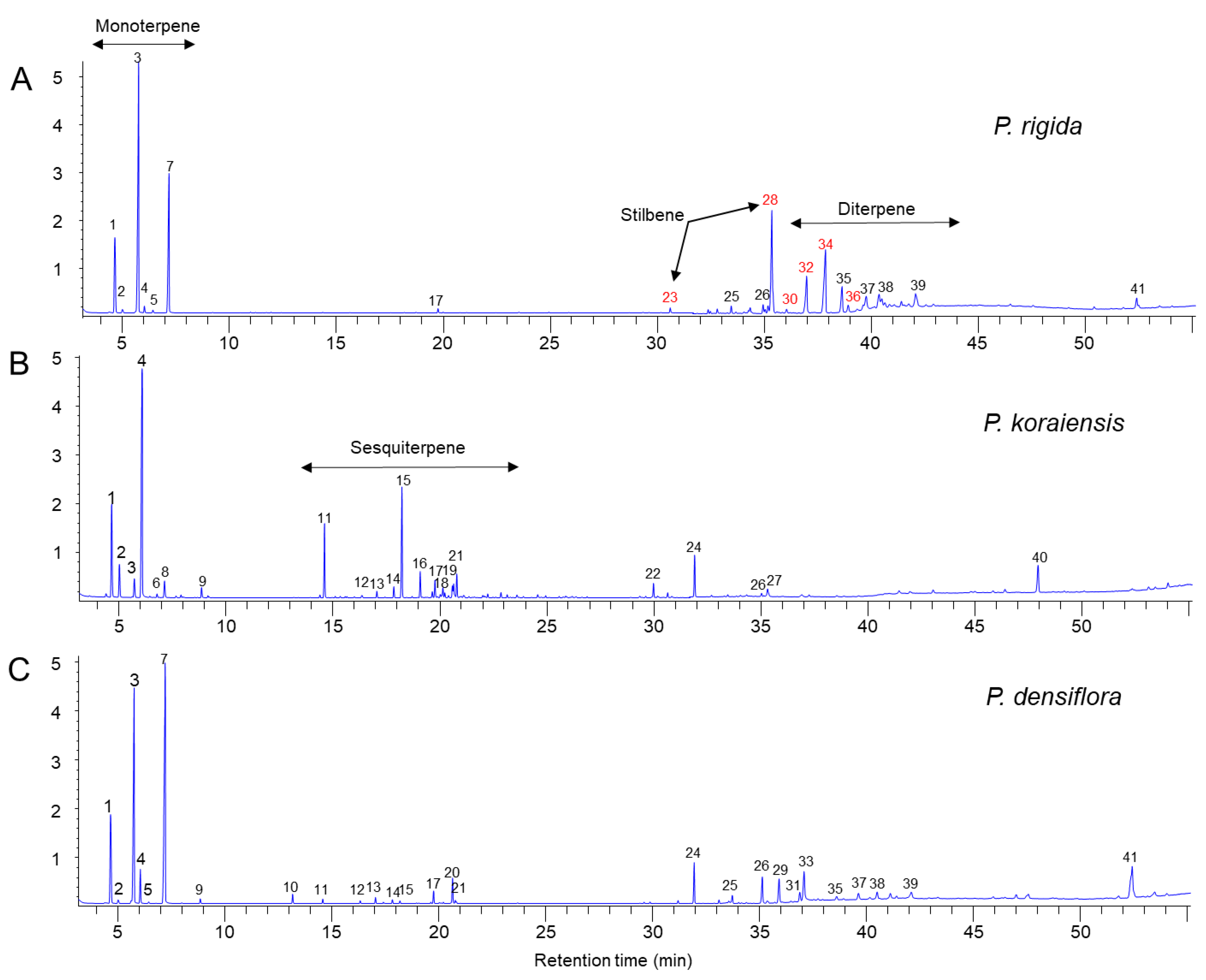
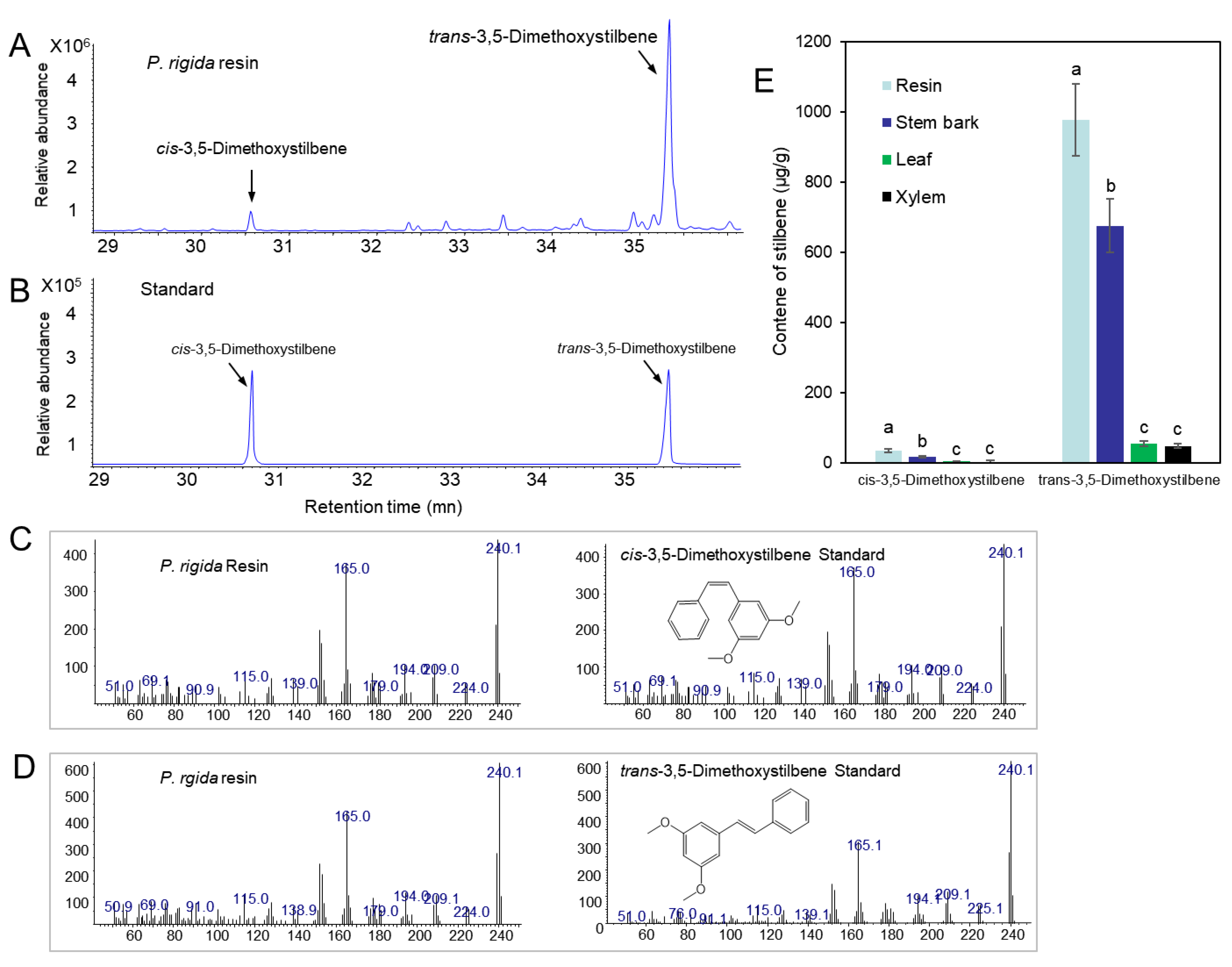
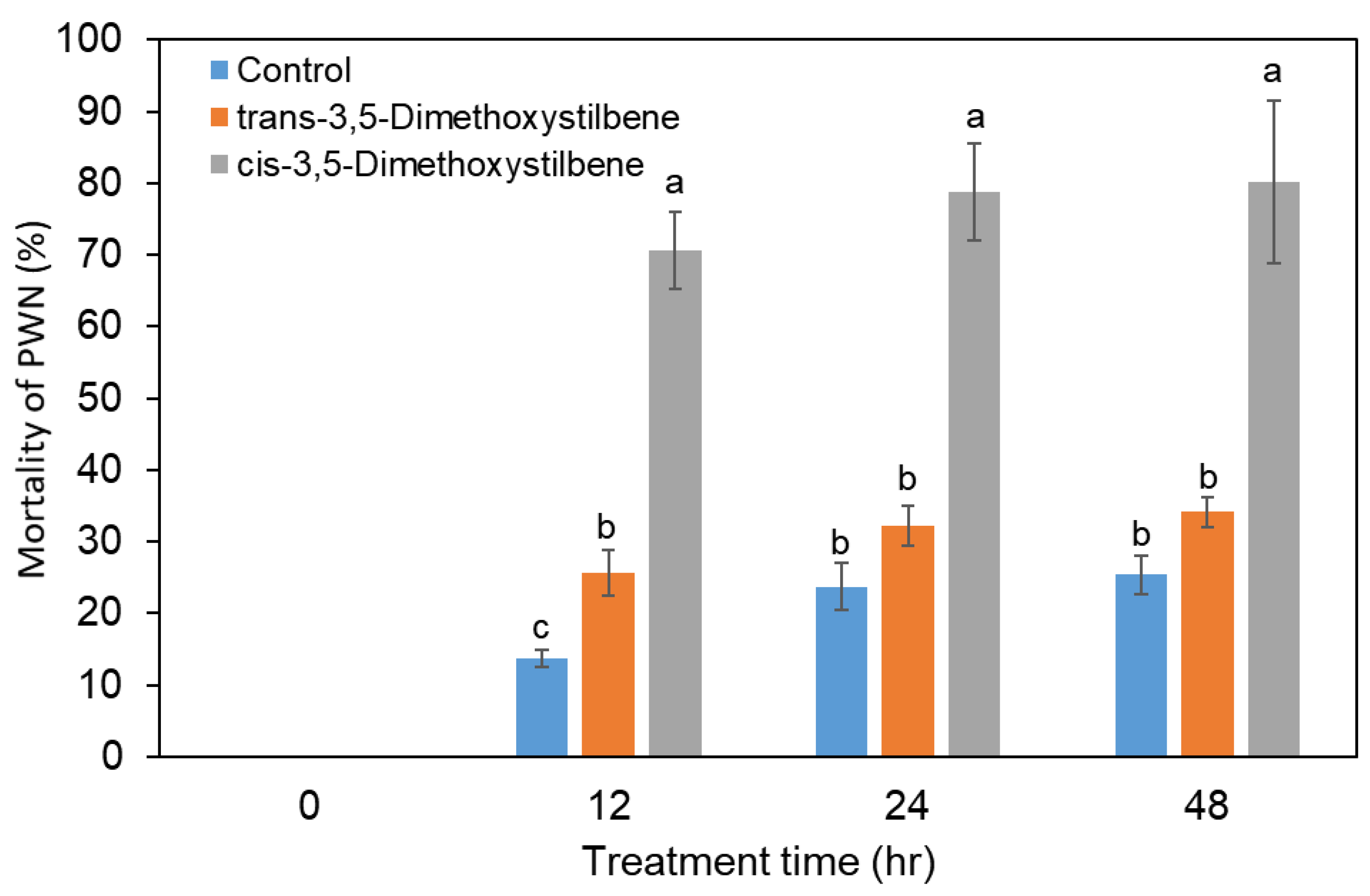
| Peak Number | Retention Time (min) | Compound Name | Peak Area | |||
|---|---|---|---|---|---|---|
| Classfication | P. densiflora | P. koraiensis | P. rigida | |||
| 1 | 4.66 | α-Pinene | Mono | 11.56 | 10.37 | 10.74 |
| 2 | 5.01 | Camphene | Mono | 0.50 | 3.64 | 0.50 |
| 3 | 5.76 | β-Pinene | Mono | 24.36 | 2.07 | 29.83 |
| 4 | 6.04 | β-Myrcene | Mono | 3.20 | 29.62 | 0.75 |
| 5 | 6.43 | α-Phellandrene | Mono | 0.37 | – | 0.32 |
| 6 | 6.80 | 3-Carene | Mono | – | 0.36 | – |
| 7 | 7.18 | β-Phellandrene | Mono | 34.71 | – | 17.59 |
| 8 | 7.23 | Limonene | Mono | – | 1.92 | – |
| 9 | 8.86 | Cyclohexene,4-methyl-3-(1-methylethylidene)- | Sesqui | 0.49 | 1.08 | – |
| 10 | 13.18 | Thymyl methyl ether | Sesqui | 0.90 | – | – |
| 11 | 14.62 | 2-Camphanol acetate | Sesqui | 0.41 | 6.60 | – |
| 12 | 16.37 | α-Longipinene | Sesqui | 0.35 | 0.36 | – |
| 13 | 17.04 | Copaene | Sesqui | 0.60 | – | |
| 14 | 17.83 | Longifolene | Sesqui | 0.58 | 1.04 | – |
| 15 | 18.23 | β-Caryophyllene | Sesqui | 0.36 | 10.37 | – |
| 16 | 19.07 | α-Caryophyllene | Sesqui | – | 2.43 | – |
| 17 | 19.74 | β-Cubebene | Sesqui | 1.22 | 1.64 | 0.46 |
| 18 | 20.13 | τ-Elemene | Sesqui | – | 1.07 | – |
| 19 | 20.40 | β-Bisabolene | Sesqui | – | 0.26 | – |
| 20 | 20.65 | (-)-δ-Cadinal lke | Sesqui | 2.64 | 1.54 | – |
| 21 | 20.78 | δ-Cadinene | Sesqui | 0.34 | 2.18 | – |
| 22 | 29.95 | Geranyl linalool | Diter | – | 1.82 | – |
| 23 | 30.58 | Cis-3,5-dimethoxystilbene | Stilbene | – | – | 0.58 |
| 24 | 31.94 | Thunbergol | Diter | 2.17 | 2.93 | – |
| 25 | 33.47 | 18-Oxokauran-17-yl acetate | Diter | 0.62 | – | 0.47 |
| 26 | 35.12 | Pimara-7,15-dien-3-one | Diter | 1.86 | 0.26 | 0.61 |
| 27 | 35.24 | Pimara-7,15-dien-3-one-related | Diter | – | 1.02 | – |
| 28 | 35.36 | Trans-3,5-dimethoxystilbene | Stilbene | – | – | 9.36 |
| 29 | 35.91 | Androstane-3,17-dione | Diter | 1.92 | – | – |
| 30 | 36.05 | Dehydroabietic aldehyde | Diter | – | – | 0.32 |
| 31 | 36.85 | Methyl palustrate | Diter | 0.84 | – | – |
| 32 | 36.96 | Unknown diterpene | Diter | – | – | 3.13 |
| 33 | 37.09 | Agathadiol | Diter | 1.92 | – | – |
| 34 | 37.87 | Methyl dehydroabietate | Diter | – | – | 7.45 |
| 35 | 38.64 | Unknown diterpene | Diter | 0.32 | – | 2.59 |
| 36 | 38.92 | Methyl abietate | Diter | – | – | 0.70 |
| 37 | 39.76 | Cinnamyl cinnamate | Phenylpropan | 0.62 | – | 1.74 |
| 38 | 40.49 | Methyl noeabietate-like | Diter | 0.58 | – | 0.91 |
| 39 | 42.13 | Methyl 7,13,15-abietatrienoate | Diter | 0.96 | – | 3.35 |
| 40 | 48.07 | Methyl steviol | Diter | – | 2.32 | – |
| 41 | 52.34 | Ergosteryl acetate | Triter | 4.75 | 0.47 | 0.96 |
Publisher’s Note: MDPI stays neutral with regard to jurisdictional claims in published maps and institutional affiliations. |
© 2022 by the authors. Licensee MDPI, Basel, Switzerland. This article is an open access article distributed under the terms and conditions of the Creative Commons Attribution (CC BY) license (https://creativecommons.org/licenses/by/4.0/).
Share and Cite
Hwang, H.-S.; Kim, Y.-R.; Han, J.-Y.; Choi, Y.-E. Nematicidal Properties and Chemical Composition of Pinus rigida Mill. Resin against Pinewood Nematodes. Forests 2022, 13, 1131. https://doi.org/10.3390/f13071131
Hwang H-S, Kim Y-R, Han J-Y, Choi Y-E. Nematicidal Properties and Chemical Composition of Pinus rigida Mill. Resin against Pinewood Nematodes. Forests. 2022; 13(7):1131. https://doi.org/10.3390/f13071131
Chicago/Turabian StyleHwang, Hwan-Su, Yi-Re Kim, Jung-Yeon Han, and Yong-Eui Choi. 2022. "Nematicidal Properties and Chemical Composition of Pinus rigida Mill. Resin against Pinewood Nematodes" Forests 13, no. 7: 1131. https://doi.org/10.3390/f13071131
APA StyleHwang, H.-S., Kim, Y.-R., Han, J.-Y., & Choi, Y.-E. (2022). Nematicidal Properties and Chemical Composition of Pinus rigida Mill. Resin against Pinewood Nematodes. Forests, 13(7), 1131. https://doi.org/10.3390/f13071131






